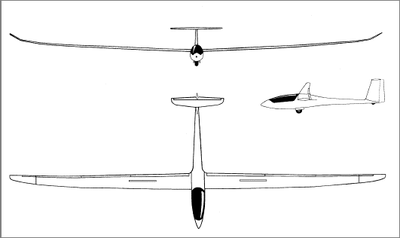Tue, Mar 08, 2022
AD 2022-05-05 Requires Inspecting The Affected Parts Of The Flaperon Control In The Wings...
The FAA is adopting a new airworthiness directive (AD) for all Schempp-Hirth Flugzeugbau GmbH Model Ventus-2a and Ventus-2b gliders.

This AD was prompted by mandatory continuing airworthiness information (MCAI) originated by an aviation authority of another country to identify and correct an unsafe condition on an aviation product. The MCAI describes the unsafe condition as severe corrosion on the inboard flaperon actuation push rods and ball bearing connecting the flaperon push rod to the bell crank inside the wing. This AD requires inspecting the affected parts of the flaperon control in the wings and taking corrective actions if necessary. The FAA is issuing this AD to address the unsafe condition on these products. This AD is effective April 11, 2022.
Supplementary Information: The FAA issued a notice of proposed rulemaking (NPRM) to amend 14 CFR part 39 by adding an AD that would apply to all Schempp-Hirth Flugzeugbau GmbH Model Ventus-2a and Ventus-2b gliders. The NPRM published in the Federal Register on December 6, 2021 (86 FR 68937). The NPRM was prompted by MCAI originated by the European Union Aviation Safety Agency (EASA), which is the Technical Agent for the Member States of the European Union. EASA issued AD 2020-0063, dated March 18, 2020 (referred to after this as “the MCAI”), to address an unsafe condition on Schempp-Hirth Flugzeugbau GmbH Models Ventus-2a, Ventus-2b, Ventus-2c, Ventus-2cM, and Ventus-2cT gliders.
The MCAI states:
- Severe corrosion has been found on the inboard flaperon actuation push rod of some sailplanes. Subsequent investigation determined that, when water ballast is dumped in flight, some water may be sucked into the wing upper side and enter the wing via the flaperon push rod. Intruding water may cause corrosion especially on the ball bearing connecting the flaperon push rod to the bell crank inside the wing.
- This condition, if not detected an[d] corrected, could lead to hard steering (when the ball bearing is damaged) or increased play (when the ball bearing has failed), possibly resulting in reduced control of the (powered) sailplane.
- To address this potential unsafe condition, Schempp-Hirth Flugzeugbau GmbH issued the [technical note] TN to provide inspection and replacement instructions.
- For the reason described above, this [EASA] AD requires repetitive inspections of the affected parts, as identified in the TN, and, depending on findings, replacement with serviceable parts.
You may examine the MCAI in the AD docket at https://www.regulations.gov by searching for and locating Docket No. FAA-2021-1019.
In the NPRM, the FAA proposed to require compliance with the version of the TN (revision 2) identified in the MCAI. The FAA is issuing this AD to address the unsafe condition on these products.
More News
Airplane Bounced About 3 Ft Then Touched Back Down And Then, With No Brakes Applied, The Airplane Began Veering To The Left Analysis: The pilot entered the airport traffic pattern >[...]
Aero Linx: British Microlight Aircraft Association (BMAA) The primary focus within all aviation activity is SAFETY. In all aspects of our sport SAFETY must come first, whether it b>[...]
From SnF25 (YouTube Edition): William Wynne Builds Practical Aircraft Engines on the Corvair Platform Seeking an affordable alternative to the traditional aircraft engine options, >[...]
How To Get A Story On Aero-TV News/Feature Programming How do I submit a story idea or lead to Aero-TV? If you would like to submit a story idea or lead, please contact Jim Campbel>[...]
From 2023 (YouTube Edition): Bridge of CiES CiES Inc. is a Bend, Oregon-based designer and manufacturer of modular embedded aircraft systems and sensors. The company’s fuel-l>[...]
 NTSB Final Report: Aviat A1
NTSB Final Report: Aviat A1 ANN's Daily Aero-Linx (07.08.25)
ANN's Daily Aero-Linx (07.08.25) Classic Aero-TV: Fly Corvairs Reliable Engine Alternative
Classic Aero-TV: Fly Corvairs Reliable Engine Alternative ANN FAQ: Contributing To Aero-TV
ANN FAQ: Contributing To Aero-TV Classic Aero-TV: CiES Fuel-Quantity and e-Throttle Systems Praised
Classic Aero-TV: CiES Fuel-Quantity and e-Throttle Systems Praised



